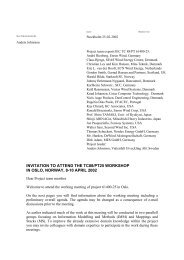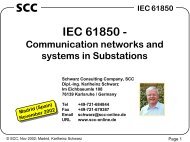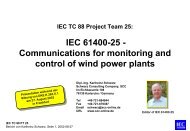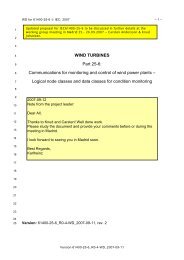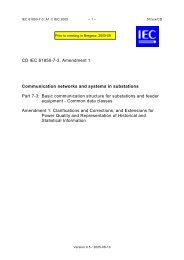Basic approach of IEC 61400-25 - scc-online.de
Basic approach of IEC 61400-25 - scc-online.de
Basic approach of IEC 61400-25 - scc-online.de
Create successful ePaper yourself
Turn your PDF publications into a flip-book with our unique Google optimized e-Paper software.
<strong>Basic</strong> Approach <strong>of</strong><br />
<strong>61400</strong>-<strong>25</strong> <strong>61400</strong> <strong>25</strong><br />
Erich W. Gunther<br />
EnerNex Corporation<br />
erich@enernex.com
Approach – Key Concepts<br />
Focus on requirements <strong>of</strong> monitoring and control<br />
functions.<br />
Numerous wind power plant topologies are<br />
supported<br />
The mo<strong>de</strong>l for <strong>de</strong>scribing information objects and<br />
services is in<strong>de</strong>pen<strong>de</strong>nt <strong>of</strong> the communication<br />
protocol and physical media.<br />
The standard allows mappings to different<br />
protocols and implementation on various<br />
physical media.<br />
The communication protocol stack, to the<br />
maximum extent possible, should make use <strong>of</strong><br />
existing standards.
Table <strong>of</strong> Contents<br />
1 Scope<br />
2 Normative references<br />
3 Terms and <strong>de</strong>finitions<br />
4 Abbreviated terms<br />
5 Overall <strong>de</strong>scription <strong>of</strong> <strong>IEC</strong> <strong>61400</strong>-<strong>25</strong> <strong>61400</strong> <strong>25</strong><br />
6 Wind power plant information mo<strong>de</strong>l<br />
7 Information exchange mo<strong>de</strong>l<br />
8 Specific mappings to communication protocols<br />
9 Configuration <strong>of</strong> wind power plant components<br />
Conformance testing
Table <strong>of</strong> Contents - Annexes<br />
A Mapping to ISO 9506 (MMS)<br />
B Mapping process data to <strong>IEC</strong> 60870-5-101/104<br />
60870 101/104<br />
C Mapping to web services<br />
D Mapping DNP3<br />
E Value range for units and multiplier<br />
F Comparison <strong>of</strong> <strong>IEC</strong> 60870-5-101/<br />
60870 101/-103/ 103/-104, 104, DNP3,<br />
and <strong>IEC</strong> 61850<br />
G Interfaces – Implementation consi<strong>de</strong>rations<br />
H From the mo<strong>de</strong>l through the message on the wire<br />
I The WSDL specification for the mapping to web<br />
services.
Clause 5 – Overview <strong>of</strong> <strong>61400</strong>-<strong>25</strong> <strong>61400</strong> <strong>25</strong><br />
5 Overall <strong>de</strong>scription <strong>of</strong> <strong>IEC</strong> <strong>61400</strong>-<strong>25</strong><br />
5.1 General<br />
5.2 Objectives and user <strong>of</strong> the standard<br />
5.3 Top-down view on wind power plants<br />
5.3.1 Definition <strong>of</strong> wind power plants<br />
5.3.2 Wind power plant components<br />
5.4 Requirements on communication<br />
5.4.1 Communication capability<br />
5.4.2 Communication content<br />
5.4.3 Communication functions<br />
5.4.4 Communication performance<br />
5.5 Communication mo<strong>de</strong>l <strong>of</strong> <strong>IEC</strong> <strong>61400</strong>-<strong>25</strong><br />
5.5.1 Introduction<br />
5.5.2 Application topology examples<br />
5.5.3 Wind power plant information mo<strong>de</strong>l<br />
5.5.4 Information exchange mo<strong>de</strong>l and relation to<br />
wind power plant information mo<strong>de</strong>ls<br />
5.5.5 Mapping to communication pr<strong>of</strong>ile
Objectives <strong>of</strong> <strong>61400</strong>-<strong>25</strong> <strong>61400</strong> <strong>25</strong><br />
To be used world-wi<strong>de</strong> world wi<strong>de</strong> by the wind power industry as a<br />
communication standard for the monitoring and control <strong>of</strong> wind<br />
power plants.<br />
To be implemented by vendors (manufactures and suppliers) <strong>of</strong><br />
wind power plant components and system integrators into their<br />
systems to create a standard basis for vendor-in<strong>de</strong>pen<strong>de</strong>nt<br />
vendor in<strong>de</strong>pen<strong>de</strong>nt<br />
monitoring and control.<br />
To be used by operators and owners <strong>of</strong> wind power plants, as well<br />
as utility companies and other parties, to monitor and control the the<br />
components used for the operation <strong>of</strong> wind power plants on a<br />
standard basis.<br />
To be as compatible as possible with other utility communications<br />
communications<br />
standards such that interoperability with these systems can be<br />
achieved with a minimum amount <strong>of</strong> time, money, and interfacing<br />
<strong>de</strong>vices.<br />
To be consi<strong>de</strong>red by planners <strong>of</strong> wind power plants and <strong>de</strong>signers <strong>of</strong><br />
wind power plant components in their current and future projects. projects.
Communication Content<br />
Process information<br />
Cumulative information<br />
Historical information<br />
Setting information<br />
Meta-information<br />
Meta information<br />
Information about available attributes, types,<br />
and other run-time run time information
Communication Functions<br />
Operational<br />
Management<br />
Operational functions<br />
Supervision / monitoring<br />
Logging and reporting<br />
Data retrieval<br />
Control<br />
Management functions<br />
User / access<br />
management<br />
Time synchronisation<br />
Diagnostics (selfmonitoring)<br />
Configuration functions<br />
Range <strong>of</strong> application (practical use)<br />
Local or remote monitoring <strong>of</strong> the status and<br />
changes <strong>of</strong> states (indications) for wind<br />
power plants.<br />
Analysing, reporting, evaluating <strong>of</strong> wind power<br />
plants.<br />
Archiving, exporting, restoring <strong>of</strong> data.<br />
Changing and modifying, intervening, switching,<br />
controlling, parameterising, optimising <strong>of</strong><br />
wind power plants.<br />
Range <strong>of</strong> application (practical use)<br />
Setting up, modifying, <strong>de</strong>leting users<br />
(administratively), assigning access rights<br />
(administratively), monitoring access<br />
Synchronisation <strong>of</strong> <strong>de</strong>vices within a<br />
communication system.<br />
This function is used to set up and provi<strong>de</strong> for<br />
self-monitoring <strong>of</strong> the communication<br />
system.<br />
Defining how the information exchange will take<br />
place; setting, changing and receiving<br />
(retrieval) <strong>of</strong> configuration data.
Communications Mo<strong>de</strong>l<br />
Input<br />
Data<br />
information formatted<br />
according to <strong>61400</strong>-<strong>25</strong><br />
Wind power plant<br />
information mo<strong>de</strong>l<br />
<strong>de</strong>fined by by <strong>IEC</strong> <strong>61400</strong>-<strong>25</strong><br />
Standard frame <strong>of</strong><br />
interpretation for data input<br />
Processing<br />
Wind power plant<br />
information exchange<br />
<strong>de</strong>fined by by <strong>IEC</strong> <strong>61400</strong>-<strong>25</strong><br />
Standard way <strong>of</strong><br />
presentation <strong>of</strong> the<br />
information to<br />
clients<br />
Communication<br />
Output<br />
Information<br />
Server
Communication Mo<strong>de</strong>l<br />
<strong>61400</strong>-<strong>25</strong><br />
Services<br />
TCP/IP<br />
Network Prot.<br />
Mapping<br />
mapping to<br />
protocol<br />
stack<br />
<strong>61400</strong>-<strong>25</strong> logical part<br />
<strong>of</strong> component (Rotor)<br />
Hi<strong>de</strong>s/encapsulates real World<br />
(Virtual World)<br />
LN<br />
WROT<br />
LN<br />
LN<br />
...<br />
configuration file<br />
Speed<br />
Position<br />
logical component<br />
<strong>61400</strong>-<strong>25</strong> data<br />
(Rotor Speed)<br />
virtualisation<br />
Real<br />
component in<br />
wind turbine
Server<br />
Logical Device<br />
Logical No<strong>de</strong><br />
Control<br />
Data on<br />
<strong>de</strong>mand<br />
Subscribe<br />
values on<br />
values<br />
values<br />
change, on<br />
on<br />
event,<br />
change,<br />
change,<br />
event,<br />
event,<br />
periodic<br />
periodic<br />
periodic<br />
reference<br />
Query<br />
Authorisation<br />
Server View<br />
Data on<br />
<strong>de</strong>mand<br />
Data<br />
Data<br />
nameplate, health<br />
Report Control Block<br />
Log<br />
Data on<br />
<strong>de</strong>mand<br />
Data Values<br />
Log Control Block<br />
Data<br />
Data<br />
Set<br />
Set<br />
Time Synchronisation File Transfer<br />
bidirectional information exchange<br />
unidirectional information exchange<br />
Logical No<strong>de</strong><br />
Data
Multiple Topologies Supported<br />
Remote<br />
SCADA<br />
Client<br />
C<br />
Router<br />
Legend: A C D E<br />
<strong>IEC</strong> <strong>61400</strong>-<strong>25</strong> standard communication<br />
B<br />
proprietary communication<br />
A<br />
Server<br />
Server<br />
(Gateway)<br />
Server<br />
Local SCADA<br />
Other<br />
components<br />
Server<br />
Propr.<br />
Client<br />
Client<br />
B<br />
D<br />
Server<br />
E<br />
Propr.<br />
Server
Clause 6 – The Good Stuff<br />
Breaks down a WPP into basic building blocks<br />
based on function and real-world real world realization –<br />
Logical No<strong>de</strong>s<br />
For each logical no<strong>de</strong>, <strong>de</strong>fines the equivalent <strong>of</strong><br />
an old fashioned “points list” only uses names<br />
instead <strong>of</strong> an in<strong>de</strong>x or memory <strong>of</strong>fset – standard<br />
names for standard things<br />
Each attribute has a type which can be simple<br />
(e.g. REAL4, INT32) or complex (e.g. a structure<br />
or array)
LN classes<br />
WTUR<br />
WROT<br />
WTRM<br />
WGEN<br />
WCNV<br />
WGDC<br />
WNAC<br />
WYAW<br />
WTOW<br />
WMET<br />
WALM<br />
WSLG<br />
WALG<br />
WREP<br />
Description<br />
Logical No<strong>de</strong>s<br />
Wind turbine general information<br />
Wind turbine rotor information<br />
Wind turbine transmission information<br />
Wind turbine generator information<br />
Wind turbine converter information<br />
Wind turbine grid connection information<br />
Wind turbine nacelle information<br />
Wind turbine yawing information<br />
Wind turbine tower information<br />
Wind power plant meteorological information<br />
Wind turbine alarm information<br />
Wind turbine state log information<br />
Wind turbine analogue log information<br />
Wind turbine report information<br />
M/O<br />
M<br />
M<br />
O<br />
M<br />
O<br />
M<br />
O<br />
M<br />
O<br />
M<br />
M<br />
O<br />
O<br />
O
Standard Names for Standard Things<br />
WTUR class<br />
Attribute Name Attr. Type Explanation T M/C/O<br />
LNName Shall be inherited from Logical-No<strong>de</strong> Class (see <strong>IEC</strong> 61850-7-2)<br />
Data<br />
General information<br />
LN shall inherit all Mandatory Data from Wind Power Plant Common<br />
Logical No<strong>de</strong> Class (see Error! Reference source not found.)<br />
TurAvlTm TMS Turbine availability time M<br />
TurOpTm TMS Turbine operation time O<br />
TurStrCt CTE Number <strong>of</strong> turbine starts O<br />
TurStpCt CTE Number <strong>of</strong> turbine stops O<br />
State information<br />
TurSt STV Windturbine status M<br />
Analogue information<br />
TotEgyAt AMV Total active energy generation M<br />
TotEgyRt AMV Total reactive energy generation O<br />
TotPwrAt AMV Total active power production M<br />
TotPwrRt AMV Total reactive power production O<br />
Control information<br />
SetTurOp CMD Windturbine operation command: Str | Stp | Auto M<br />
Setpoint information<br />
DmdPwrAt SPV Turbine active power production setpoint O<br />
DmdPwrRt SPV Turbine reactive power production setpoint O<br />
DmdPwf SPV Turbine power factor setpoint O<br />
M
Attribute type<br />
<strong>Basic</strong> Types<br />
Name Range / explanation<br />
BOOLEAN True | False<br />
INT8 -128 to +127<br />
INT16 -32.768 to +32.767<br />
INT24 -8.388.608 to 8.388.607<br />
INT32 -2**32 to (2**32)-1<br />
INT128 -2**127 to (2**127)-1<br />
INT8U 0 to <strong>25</strong>5<br />
INT16U 0 to 65.535<br />
INT24U 0 to 16 777 215<br />
INT32U 0 to 4.294.967.295<br />
FLOAT32 single precision floating point, range and precision as specified by IEEE<br />
754 single precision floating popint.<br />
FLOAT64 double precision floating point, range and precision as specified by<br />
IEEE 754 double precision floating popint.<br />
ENUMERATED Or<strong>de</strong>red set <strong>of</strong> values <strong>de</strong>pen<strong>de</strong>nt <strong>of</strong> information to be mo<strong>de</strong>led; custom<br />
extensions are allowed<br />
CODED ENUM Or<strong>de</strong>red set <strong>of</strong> values, <strong>de</strong>fined once; custom extensions are not<br />
allowed. Type shall be mapped to an efficient encoding in the mappings<br />
VISIBLE STRING ASCII string
More Complex Types<br />
Like a C Language Structure or a C++ Language Class<br />
TimeStamp type <strong>de</strong>finition<br />
Attribute name Attribute type Value/value range/explanation M/O<br />
SecondSinceEpoch INT32 (0...MAX) M<br />
FractionOfSecond INT24U Value = SUM from i=0 to 23 <strong>of</strong> bi*2**–(i+1);<br />
Or<strong>de</strong>r = b0, b1, b2, b3, ...<br />
TimeQuality TimeQuality M<br />
AnalogueValue Type Definition<br />
Attribute Name Attribute Type Value/Value Range M/O/C<br />
i INT32 integer value GC_1 a)<br />
f FLOAT32 floating point value GC_1 a)<br />
a) GC_1 = At least one <strong>of</strong> the attributes shall be present for a given instance <strong>of</strong> DATA.<br />
M
Clause 7 – Information Mo<strong>de</strong>l<br />
This clause <strong>de</strong>scribes the information<br />
mo<strong>de</strong>ling <strong>approach</strong>. It borrows heavily<br />
from <strong>IEC</strong> 61850 and is compatible with it.<br />
It is inclu<strong>de</strong>d/repeated in the standard so<br />
that the document can be more useful as a<br />
“stand alone” document.
Clause 8 – Protocol Mappings<br />
The logical mo<strong>de</strong>l is in<strong>de</strong>pen<strong>de</strong>nt <strong>of</strong> the un<strong>de</strong>rlying<br />
protocol used to transport the data.<br />
The un<strong>de</strong>rlying protocol is generally in<strong>de</strong>pen<strong>de</strong>nt <strong>of</strong> the<br />
physical media used to provi<strong>de</strong> connectivity <strong>of</strong> the<br />
<strong>de</strong>vices<br />
61850 formally <strong>de</strong>fines one mapping – ISO 9506 – MMS.<br />
<strong>61400</strong>-<strong>25</strong> <strong>61400</strong> <strong>25</strong> <strong>de</strong>fines 4. 61850 could and should utilize the<br />
additional mappings and immediately make it a more<br />
flexible standard<br />
Additional mappings are possible but maybe not<br />
<strong>de</strong>sirable for simplicity <strong>of</strong> interoperability<br />
Protocol mapping flexibility is best used to track<br />
communications industry technological advancement<br />
rather than the ability to support your favorite protocol
Annexes<br />
The annexes contain a bunch <strong>of</strong><br />
information that s<strong>of</strong>tware <strong>de</strong>velopers need<br />
to know to implement the standard<br />
Mainly <strong>de</strong>scribes the gritty <strong>de</strong>tails for the<br />
protocol mappings – geeks only please!
Conclusion<br />
The standard document must balance several factors:<br />
Two audiences<br />
Electric power engineers with a specialty in wind<br />
Communication & information engineers & s<strong>of</strong>tware <strong>de</strong>velopers<br />
The <strong>de</strong>sire for a stand-alone stand alone document with enough information to<br />
implement the standard versus the <strong>de</strong>sire for a document with only only<br />
the wind industry specific information and references to all other other<br />
standards and other documents necessary to use the standard –<br />
tough call<br />
Approach based on mo<strong>de</strong>rn object oriented communications<br />
mo<strong>de</strong>ling <strong>approach</strong> and standards<br />
In<strong>de</strong>pen<strong>de</strong>nt <strong>of</strong> specific protocols and physical media<br />
Extensible without obsolescence as new capabilities<br />
required and technology advances<br />
Supports continuum <strong>of</strong> simple, bandwidth constrained<br />
<strong>de</strong>vices/systems to extensive, high point count <strong>de</strong>vices,<br />
systems and gateways connected to high speed networks



